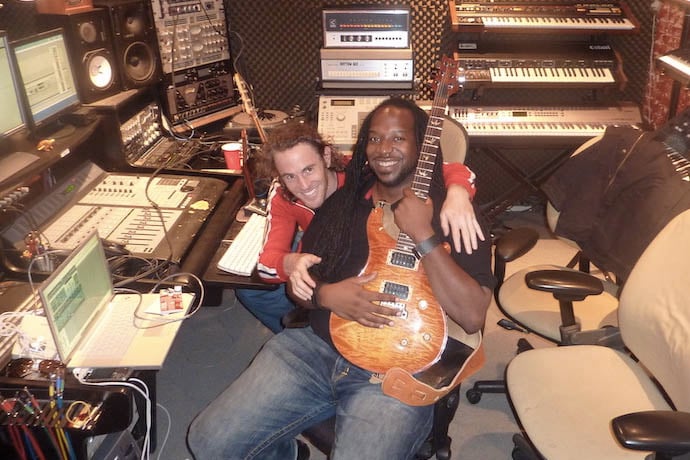The screen shows uninspired squiggles. But you don’t look away because the music pulls you in. The squiggles fall into the shape of a computer control key, the logo of the company appears and their message that they are in control flashes off screen. The graphics for the short are fine, but the music is memorable. It gives weight to the abstract and makes the strange lines on the screen feel alive.
Composer, musician and Grammy-nominated producer James McKinney is in charge of that music. He lays down a melody line, then harmony, then another, adjusts the volumes and reverb until the music is as perfect as it can get.
“When I am manipulating the music, I am doing the Arts part of STEAM,” he said. “Building the software is the science, technology, engineering and math.”
McKinney makes the adjustments on the computer screen using a software package called Waves. Someone else coded the package, and he is grateful. “Coding,” he said, “is the glue between the physical and digital realms of music.” McKinney did a bit of coding when he was in high school, but the programs now are beyond anything he ever worked on.
He also started his journey in engineering while he was still in high school. He first went into studios as a musician, recording onto tape as he chased the dream of being a rock superstar. Then he became a sound engineer himself. “I transitioned really quickly from analogue to digital,” he said.
He learned the physics of recording sound and how the waves are represented on the screens he uses. He learned the ease of duplicating sections of rhythms throughout a song. He learned to add or subtract tones from voices or instruments.
Now, as a composer as well as a sound engineer, he knows that the real instruments sound much better than the digital ones. But he can use the fake strings and fake brass as a sketch within his scores.
Once he gets other musicians to play, he can hear his sketch played. “You don’t know until you hear it if it’s going to work and if it’s going to be what you thought,” he said. When it works it is a moment of bliss. “I’m touching God, or God is touching me. It’s amazing.”
Caribbean Recordings
Which brings him to another project, building studios so others can learn to do what he does. McKinney and his business partner, Scott Jacoby, own Eusonia Records with recording studios in New York City. Six years ago, Eusonia was invited to be a consultant on a non-profit project, Anguilla Musical Academy. Anguilla is an island nation east of Puerto Rico.The goal of AMA is to build world-class studios and open an engineering school. The whole project is ready to launch once COVID is over, he said. “We want to be able to give the youth of the Caribbean the option to stay in their court and learn.”
Coding an Encore
Among other activities, the students there are going to learn coding. And while the graduates of these classes don’t need to focus only on sound, he is hopeful that they may be working toward the next set of more sophisticated musical software: computers that will aid in song writing.
Right now, machines are getting to where they can play simple songs, or play regular beats on a par with humans. But more complicated songs are all human. For example, McKinney points at piano jazz great Joey Alexander. Alexander breathes into the sound, holding notes just a little longer than is written, giving the song character and depth. Those interpretations defy easy coding.
Five-time Grammy-award winner Jacob Collier is another example. While he uses computers in his presentations and composition, Collier’s also adds amazing chord progressions and harmonies that inspire other musical humans. Computers composition programs are left in the dust.
But that won’t always be true, McKinney says. He expects artificial intelligence to learn how to interpret and create songs by “breaking the measures into millions or even billions of pieces.” Each of those pieces will have decisions made about the length of the notes, the volume of the notes, and all of the other choices musicians make. Then the computer will put the measure back together, just as our brain does.
And when that happens, the computer will be as much an art form as the composer’s job is now, essentially putting the A firmly back in the STEAM project.
Learn More
Scott Jacoby’s New York Story
https://www.mixonline.com/recording/scott-jacobys-new-york-story
Greenbelt’s James McKinney
Computer music
https://en.wikipedia.org/wiki/Computer_music
Best Music notation software
https://www.toptenreviews.com/best-music-notation-software

